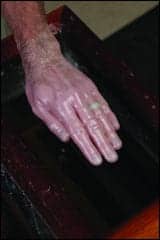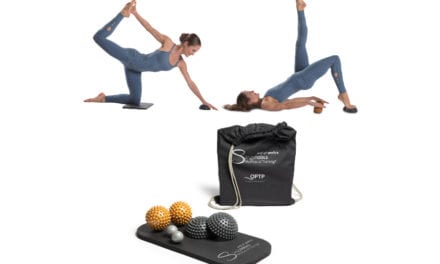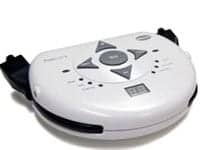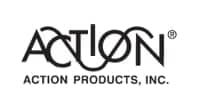 |
“Pain is such an uncomfortable feeling that even a tiny amount of it is enough to ruin every enjoyment.”
—WILL ROGERS (1879-1935), AMERICAN HUMORIST
Modern pain modalities can help manage pain and aid healing. Pain does have a protective function in nature, warning of damage and promoting careful treatment of the affected area. However, pain can be destructive, too: by heightening the cellular stress response, the autonomic, somatic, and endocrine reflexes are diminished, resulting in protein breakdown, platelet aggregation, nausea, and a suppressed immune system. This article will examine how the modalities manage pain from acute traumas and sports injuries.
Biofeedback: Breaking the Pain Cycle
According to G.E. Sella, MD, of Martins Ferry, Ohio, an individual experiencing chronic pain should address the problem head on. Sella, an independent practitioner and researcher with an interest in soft tissue injury and pain, says, “The sooner severe pain [is acknowledged,] the better,” he says. “Chronic pain can be self-perpetuating, and it’s important to start healing as soon as possible.”
One approach to treatment is the use of biofeedback, which can help break the cycle of tension and pain following injury. Biofeedback works as electrodes on the skin monitor bodily processes (that usually occur involuntarily), such as blood pressure, muscle tension, and skin temperature. The patient learns to control these processes with the help of a practitioner. The relaxing of muscles and improved circulation may significantly reduce chronic pain.
Sella observes, “There is ample evidence that biofeedback eases the pain of chronically sore shoulders, necks, and backs.” He recommends beginning biofeedback at the first sign of pain.
“It’s also good for patients who suffer from chronic pain to feel involved in their treatment,” he says. “Biofeedback teaches the patient not to be a slave to pain, but a master of the body.”
What sort of improvements are foreseen in the use of biofeedback technology? According to Sella, some clinics are including video cameras in their biofeedback suites. “The cameras give patients quick feedback as to how to move correctly and to figure out what is provoking pain,” he says. (For example, by studying a video recording of their client’s biofeedback session, a therapist can suggest a simple change in the individual’s gait that could, over time, lessen their chronic pain.)
New biofeedback systems with as many as 10 channels and sophisticated screen configurations have been developed to help clinicians diagnose and help their clients. Sella says that some locations are even using biofeedback in an aquatic setting.
“The patient wears the electrodes while in the pool, which helps to stimulate the relaxation response,” Sella says. “Of course, everything is waterproofed, so the patient is not at risk for an electric shock,” he adds.
The Relief of Electrotherapies
Electrical stimulation, or e-stim, is another modality favored by therapists to treat clients with chronic pain. There are two main types, TENS (transcutaneous electrical nerve stimulation) and interferential current (IFC). Both work via electrodes. TENS is designed to control pain by electrical impulse. It does not cure the injury, but interrupts the painful symptoms. “Interferential current and TENS are used to decrease pain in conditions such as low-back pain and neck pain,” says Priti Ravishankar, PT, of Quinn Orthopedic Physical Therapy, Cupertino, Ca.
Interferential current therapy works by using two medium currents that interfere with each other. “IFC goes deeper and seems to last longer than TENS treatments.” says Richard Kosses, DPT, of Spaulding Rehabilitation Hospital Outpatient Center in Framingham, Mass.
According to Kosses, “[When applying TENS,] pain relief is typically expected within 5 minutes of initiation, but often does not last more than 1 hour after the treatment is stopped. Interferential current, best at frequencies of 80 Hz or higher, also works.” Kosses says that the pain relief associated with IFC usually lasts longer than that of TENS. Portable TENS and IFC at-home units give patients pain control at their fingertips whenever it is needed.
Tom Watson, DPT, MEd, of Peak Performance Physical Therapy, Redmond, Ore, has had good results using TENS for pain management, as well as cranial electrotherapy stimulation or CES. A modality similar to TENS, CES sends microcurrents to the brain via electrodes clipped to the ears. CES has been used to treat spinal, head, spinal, dental, and muscle pain, as well as control conditions associated with pain.
According to Watson, by alleviating chronic pain, CES can provide afflicted individuals with the deep sleep they need to heal. “If you don’t hit your deepest sleep in the first 2 hours, you don’t get all of your hormone restoration, and you’ll end up fatigued, in pain and tired, for the whole day.”
Brian Mock, MPT, COMT, CSCS, University of Pittsburgh Center for Sports Medicine, uses ultrasound when addressing painful tissue or muscle spasms, range-of-motion, back conditions, soft tissue injuries, and chronic conditions. Often the go-to treatment for many therapists, ultrasound provides relief through deep therapeutic heat that penetrates from 4 cm to 6 cm—deeper than any other modality.
Mock says, “[I use] ultrasound to heat tissue, work on scar tissue, and prepare patients to stretch out soft tissue as a standard part of physical therapy.”
A new development in pain relief has been the ultrasound-guided nonsurgical procedure for tendon calcification of rotator cuff tendinitis. A saline solution is injected after the shoulder is anesthetized to break up rotator cuff calcium deposits. This procedure, according to a study presented at the annual meeting of the Radiological Society of North America (RSNA), significantly reduces pain and restores mobility. The procedure takes about 10 minutes to perform, and has a postoperative recovery time of about an hour. The calcifications that are completely removed do not return, according to the study.
Diathermy, an electrically induced heat application, is a deep tissue therapy that is enjoying a resurgence of use among rehabilitation professionals for use in the relief of such discomforts as musculoskeletal pain, muscle spasms, and chronic back pain. Diathermy machines use a form of electromagnetic energy to radiate heat deep into the tissues.
“Diathermy is similar to what you’d use a heating pack for, but the concept behind diathermy is a deeper heat,” says Brian Hagen, DPT, MS, OCS, FAAOMPT, clinical assistant professor, regional director, and facility director, CRS/UPMC, and program administrator, UPMC Center for Sports Medicine, Pittsburgh.
RICE: The Universal Modality
Hot and cold therapies are some of the oldest and most popular modalities for pain relief and inflammation. Generally, ice works best on recent injuries, and heat is better for long-term chronic pain.
The acronym RICE has been used to describe the best method of treatment for many injuries: Rest, ice, compression, and elevation. Heat may feel better to the injured person than ice, and the PT may have to make a decision to go with what either does the best or feels the best for the patient. Mock finds another modality to use if the patient refuses ice. “We’ll take care of it by another means.”
 |
| Paraffin therapy is often used to reduce pain and stiffness around joints, and can be especially beneficial in the treatment of arthritis, bursitis, tendinitis, tennis elbow, and fatigued muscles. |
Cold Therapy:
- Reduces swelling following a traumatic injury
- Reduces inflammation
- Produces a numbing effect that can reduce pain
- Decreases blood flow to an area
- Decreases muscle spasms
Heat Therapy:
- Increased blood flow to an area
- Relief from tension or tightness in muscles
- May reduce joint stiffness
- Optimizes healing/rehabilitation environment in tissues through influx of cells involved in tissue repair (as a result of increased blood flow.)
- Provides pain relief
- Increase in flexibility
Heat and cold therapies can be used in a clinical and a home setting. Several short treatments (not over 15 minutes) per day seem to provide the optimum results. Cold therapy can be provided via cold pack, crushed ice, gel packs, ice towels, sprays, and compression units. Heat treatment is available through heating pads, diathermy, microwavable pads, moist towels, whirlpools, and paraffin baths. While the delivery systems may get more sophisticated, these modalities will always have a place in pain treatment.
Not Just Skin Deep
Generally applied to the skin as a cream, spray, ointment, or gel, topical anesthetics and analgesics have long been favored by both therapists and consumers to alleviate the muscular pain and discomfort associated with arthritis pain, aching muscles, tight, sore joints, as well as minor aches and pains.
Available as both over-the-counter and prescription-only purchases, topical treatments are available in a range of strengths—from milder formulae containing salicylate or NSAIDs to stronger, temporary nerve-blocking solutions with lidocaine and prilocaine. New and improved solutions are used to reduce swelling and ease pain-causing inflammation, as well as to reduce or eliminate pain in a limited area of the body. Therapists use topically applied products as a complement to such therapies as ultrasound, cryotherapy, TENS, and massage.
Iontophoresis uses low-dose electrical current to get water-soluble drugs through the skin. It can provide therapeutic benefits with low side effects. Studies have shown decreased pain in patients who suffered from musculoskeletal conditions after being treated via iontophoresis with dexamethasone.
“Iontophoresis can also be used to reduce calcium deposits, and soften scar tissue,” says Thomas M. Parkinson, PhD, a medical device and pharmaceutical products consultant, specializing in the development of novel oral and transdermal drug delivery systems. Traditional iontophoresis features treatments of 10 to 20 minutes, but within the last few years, technology has been developed that enables iontophoresis to be provided in patch form. These patches can be used in the home or clinic. Patch iontophoresis provides pain control in an easier, more independent manner for the patient.
Whether by themselves or in concert with one another, the modalities help provide relief for chronic pain.
Cathy Logan is a contributing writer for Rehab Management. For more information, please contact .
Reading and General References
- Carlson AH. Hot and cold. Rehab Management. 2007;20(10):32-33.
- Carlson AH. Plugging in to pain. Rehab Management. 2007;20(9):30-35.
- Hart JA. Overview on Biofeedback. University of Maryland. December 1, 2002.
- Kosses R. Two types of e-stim. Rehab Management. 2004;17(7):18-21,42.
- Lacelli F, Sconfienza LM, Gravano M, Silvestri E, Garlaschi G, Serafini G. Ultrasound guided percutaneous approach to the therapy of calcific tendonitis of the rotator cuff. Presented at: RSNA Annual Meeting; November 25-27, 2007; Chicago.
- Nirschl RP, Rodin DM, Ochiai DH, Maartmann-Moe C; DEX-AHE-01-99 Study Group. Iontophoretic administration of dexamethasone sodium phosphate for acute epicondylitis. Am J Sports Med. 2003;31(2):189-195.
- Rand S, Goerlich C, Marchand K, Jablecki N. The physical therapy prescription. Am Fam Physician. 2007;76:1661-1666.
- Silberstein N. Diathermy: comeback, or new technology? Rehab Management. 2008;21(1):30-33.
- Woolston C. Biofeedback and pain relief. Consumer Health Interactive. March 27, 2008.





